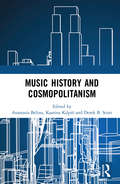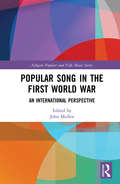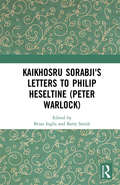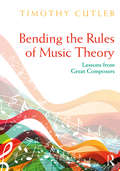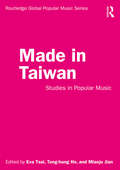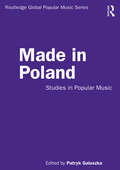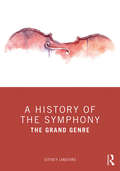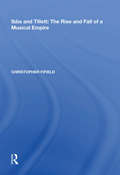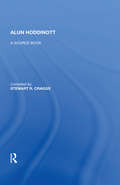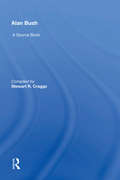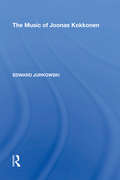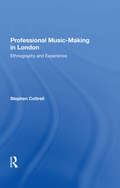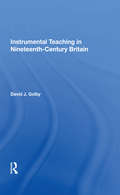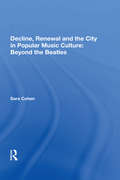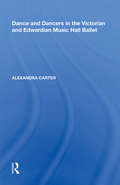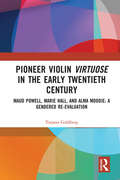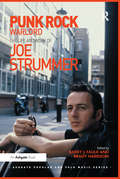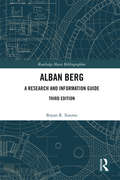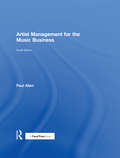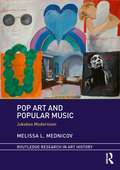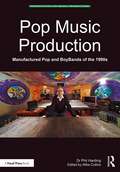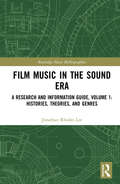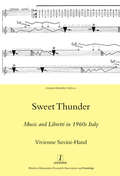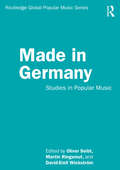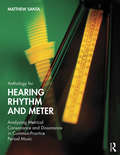- Table View
- List View
Music History and Cosmopolitanism
by Anastasia Belina Kaarina Kilpiö Derek B. ScottThis collection of essays is the first book-length study of music history and cosmopolitanism, and is informed by arguments that culture and identity do not have to be viewed as primarily located in the context of nationalist narratives. Rather than trying to distinguish between a true cosmopolitanism and a false cosmopolitanism, the book presents studies that deepen understanding of the heritage of this concept – the various ways in which the term has been used to describe a wide range of activity and social outlooks. It ranges over a two hundred-year period, and more than a dozen countries, revealing how musicians and audiences have responded to a common humanity by embracing culture beyond regional or national boundaries. Among the various topics investigated are: musical cosmopolitanism among composers in Latin America, the Ottoman Empire, and Austro-Hungarian Empire; cosmopolitan popular music historiography; cosmopolitan musical entrepreneurs; and musical cosmopolitanism in the metropolises of New York and Shanghai.
Popular Song in the First World War: An International Perspective (Ashgate Popular and Folk Music Series)
by John MullenWhat did popular song mean to people across the world during the First World War? For the first time, song repertoires and musical industries from countries on both sides in the Great War as well as from neutral countries are analysed in one exciting volume. Experts from around the world, and with very different approaches, bring to life the entertainment of a century ago, to show the role it played in the lives of our ancestors. The reader will meet the penniless lyricist, the theatre chain owner, the cross-dressing singer, fado composer, stage Scotsman or rhyming soldier, whether they come from Serbia, Britain, the USA, Germany, France, Portugal or elsewhere, in this fascinating exploration of showbiz before the generalization of the gramophone. Singing was a vector for patriotic support for the war, and sometimes for anti-war activism, but it was much more than that, and expressed and constructed debates, anxieties, social identities and changes in gender roles. This work, accompanied by many links to online recordings, will allow the reader to glimpse the complex role of popular song in people’s lives in a period of total war.
Kaikhosru Sorabji's Letters to Philip Heseltine (Peter Warlock)
by Barry Smith Brian InglisTwo extraordinary personalities, and one remarkable friendship, are reflected in the unique corpus of letters from Anglo-Parsi composer-critic Kaikhosru Sorabji (1892-1988) to Philip Heseltine (Peter Warlock) (1894-1930): a fascinating primary source for the period 1913-1922 available in a complete scholarly edition for the first time. The volume also provides a new contextual, critical and interpretative framework, incorporating a myriad of perspectives: identities, social geographies, style construction, and mutual interests and influences. Pertinent period documents, including evidence of Heseltine’s reactions, enhance the sense of narrative and expand on aesthetic discussions. Through the letters’ entertaining and perceptive lens, Sorabji’s early life and compositions are vividly illuminated and Heseltine’s own intriguing life and work recontextualised. What emerges takes us beyond tropes of otherness and eccentricity to reveal a persona and a narrative with great relevance to modern-day debates on canonicity and identity, especially the nexus of ethnicity, queer identities and Western art music. Scholars, performers and admirers of early twentieth-century music in Britain, and beyond, will find this a valuable addition to the literature. The book will appeal to those studying or interested in early musical modernism and its reception; cultural life in London around and after the First World War; music, nationality and race; Commonwealth studies; and music and sexuality.
Bending the Rules of Music Theory: Lessons from Great Composers
by Timothy CutlerFor students learning the principles of music theory, it can often seem as though the tradition of tonal harmony is governed by immutable rules that define which chords, tones, and intervals can be used where. Yet even within the classical canon, there are innumerable examples of composers diverging from these foundational "rules." Drawing on examples from composers including J.S. Bach, Mozart, Beethoven, Schubert, Mendelssohn, Chopin, Brahms, and more, Bending the Rules of Music Theory seeks to take readers beyond the basics of music theory and help them to understand the inherent flexibility in the system of tonal music. Chapters explore the use of different rule-breaking elements in practice and why they work, introducing students to a more nuanced understanding of music theory.
Made in Taiwan: Studies in Popular Music (Routledge Global Popular Music Series)
by Eva Tsai Tung-Hung Ho Miaoju JianMade in Taiwan: Studies in Popular Music serves as a comprehensive introduction to the history, sociology, and musicology of contemporary Taiwanese popular music. Each essay, written by a leading scholar of Taiwanese music, covers the major figures, styles, and social contexts of pop music in Taiwan and provides adequate context so readers understand why the figure or genre under discussion is of lasting significance. The book first presents a general description of the history and background of popular music in Taiwan, followed by essays organized into thematic sections: Trajectories, Identities, Issues, and Interactions.
Made in Poland: Studies in Popular Music (Routledge Global Popular Music Series)
by Patryk GaluszkaMade in Poland: Studies in Popular Music serves as a comprehensive introduction to the history, sociology, and musicology of contemporary Polish popular music. Each essay, written by a leading scholar of Polish music, covers the major figures, styles, and social contexts of pop music in Poland and provides adequate context so readers understand why the figure or genre under discussion is of lasting significance. The book first presents a general description of the history and background of popular music in Poland, followed by essays organized into thematic sections: Popular Music in the People’s Republic of Poland; Documenting Change and Continuity in Music Scenes and Institutions; and Music, Identity, and Critique.
A History of the Symphony: The Grand Genre
by Jeffrey LangfordA History of the Symphony: The Grand Genre identifies the underlying cultural factors that have shaped the symphony over the past three hundred years, presenting a unified view of the entire history of the genre. The text goes beyond discussions of individual composers and the stylistic evolution of the genre to address what constitutes a symphony within each historical period, describing how such works fit into the lives of composers and audiences of the time, recognizing that they do not exist in a vacuum but rather as the products of numerous external forces spurring their creation. In three parts, the text proceeds chronologically, drawing connections between musical examples across regions and eras: The Classical Symphony The Romantic Symphony The Symphony in the Modern Era Within this broad chronology—from the earliest Italian symphonies of the 18th century to the most experimental works of the 20th century—discussion of the development of the genre often breaks down along national lines that outline divergent but parallel paths of stylistic growth. In consideration of what is and is not a symphony, musical developments in other genres are presented as they relate to the symphony, genres such as the serenade, the tone poem, and the concert overture. Suitable for a one-semester course as well as a full-year syllabus, and with illustrative musical examples throughout, A History of the Symphony places composers and works in sociological and musical contexts while confronting the fundamental question: What is a symphony?
Ibbs and Tillett: The Rise and Fall of a Musical Empire
by Christopher FifieldFor the greater part of the twentieth century, Ibbs and Tillett's concert agency was to the British music industry what Marks and Spencer is to the world of the department store. The roll-call of famous musicians on its books was unmatched, and included such international stars as Clara Butt, Fritz Kreisler, Pablo Casals, Sergei Rachmaninov, Andr Segovia, Kathleen Ferrier, Myra Hess, Jacqueline du Pr Clifford Curzon and Vladimir Ashkenazy, to name but a handful. From 1906, the success of the company was due to the dedication of its founders, Robert Leigh Ibbs and John Tillett. After their deaths, the agency was run by the latter's wife, Emmie, who, dubbed the 'Duchess of Wigmore Street', became one of the most formidable yet respected women in British music. The history of this unique institution and its owners is told here for the first time, often through the fascinating letters that were exchanged between the artists themselves and the agency. It begins in the latter years of the 19th century with the concert and theatrical manager Narciso Vert, for whom both Ibbs and Tillett worked until his death in 1905. The story then becomes a history of musical life in twentieth-century Britain, illuminating aspects of the day-to-day management of concerts and festivals, the lives and livelihoods of professional musicians, as well as those who strove to join their ranks through audition or recommendation. The changing profile, and particularly the onset and development of personal management of artists represented by Ibbs and Tillett and their reception in the press, can be viewed as a barometer of musical taste. The demise of the agency in 1990 was indicative of just how much the world of British music had changed by the end of the century, but despite its loss to the profession, the legacy and influence of Ibbs and Tillett has remained a benchmark in today's highly competitive world of artist management and concert promotion, many of whose principal operators began
Alun Hoddinott: A Source Book (Bio-bibliographies In Music Ser. #No. 44)
by R. Craggs StewartAlun Hoddinott is the most important living Welsh composer and one of the most distinguished and prolific composers of his generation internationally. His works have been performed in major centres as far afield as Tokyo and Berlin, Melbourne and Leipzig, New York and Venice as well as the major festivals in Wales and England. He is one of the very few composers to have been commissioned to compose a concerto for Mstislav Rostropovitch.Born in Bargoed, Glamorganshire, in August 1929, Alun Hoddinott started to play the violin and compose at an early age. Some of his works were performed and broadcast whilst he was a student at University College, Cardiff and he later studied with the Australian composer and pianist Arthur Benjamin. His first major success was his Clarinet Concerto No.1, given by Gervaise de Peyer and the Halle Orchestra under John Barbirolli at the 1954 Cheltenham Music Festival.This Source Book lists all Hoddinott's compositions from 1946 to 2005, almost 60 years of phenomenal output, and shows he has achieved a mastery of composition which embraces almost every musical medium. With information given on first performances, manuscript locations and recordings, in addition to details of composition dates, authors/librettists, durations, commissions and dedications amongst much else, this book is a key reference for all those interested in Alun Hoddinott and his music.
Alan Bush: A Source Book
by Stewart R. CraggsBorn in 1900, Alan Bush, the English composer, conductor and pianist, studied with Corder and Matthay, and privately with John Ireland. He was appointed professor of harmony and composition at the Royal Academy of Music in 1925, a post he held until 1978. In 1929-31, he continued to study at Berlin University and had piano lessons with Moiseiwitsch and Schnabel. The present Source Book documents his works (many of which reflect his Communist sympathies) and the many arrangements of music by other composers. A wealth of detail is provided, including printed scores, CD recordings, bibliographical material and manuscript scores and their locations, the majority of which have been deposited recently in the British Library by the Bush family. A chronology of the composer's life draws on many sources including letters and scrapbooks.
The Music of Joonas Kokkonen
by Edward JurkowskiJoonas Kokkonen (1921-1996) has been one of the most performed Finnish composers during the past 25 years both within Finland and abroad.The author's study of Joonas Kokkonen is the first full-scale account in English. Starting with a brief survey of Finnish music during the 20th century, the book then devotes a separate chapter to each of the major genres in which Kokkonen composed: symphonic, orchestral, vocal, chamber and keyboard. Illustrated with over a hundred music examples, The Music of Joonas Kokkonen seeks to overturn his reputation in some quarters as a conservative, even old fashioned, composer, and argues that Kokkonen created an interesting and refreshing approach to dodecaphonic composition and pitch organization. With a full chronological listing of works and bibliography, this book is the most important reference source to date on Kokkonen and his music." "Book Description: One of the most performed Finnish composers during the last 25 years, Joonas Kokkonen (1921-1996) was also instrumental in the development of the nation's system of music education. In this study,the author (music, U. of Lethbridge, Canada) examines Kokkonen's compositions in each of five major genres: symphonic, orchestral, vocal, chamber, and key
Professional Music-making in London: Ethnography and Experience (Soas Musicology Ser.)
by Stephen CottrellProfessional Music-Making in London is an engaging yet innovative study which examines the lives and work of Western art musicians from an ethnographic perspective. Drawing in part on his own professional experience, Stephen Cottrell considers to what extent musicians in Western society conform to Alan Merriam's paradigmatic assessment of them as having low status yet high respect, as well as being given an unusual degree of licence to deviate from convention. The book draws on a wide variety of approaches from scholars elsewhere: from ethnomusicologists such as Bruno Nettl and Henry Kingsbury, performance theorists such as Richard Schechner and Victor Turner, as well as psychologists such as Sigmund Freud and Melanie Klein. This rich intellectual heritage provides the framework for discussion of a variety of themes, including how musicians conceive their self identity and how this is negotiated in the professional musical world; how the deputy system facilitates musical exchange and engenders gift relationships; how humour lubricates social and musical relationships and mitigates the stresses of musicians' lives; and how the events in which musicians participate can be viewed as quasi-rituals, and thus related to analogous events in non-Western cultures. The focus of this study is on professional music-making in London, one of the world's busiest centres of musical performance - yet the issues raised and explored are deeply relevant to other major centres of Western art music, such as New York, Berlin or Sydney. Ethnomusicologists, anthropologists, musicologists, performers, teachers and concert-goers will find this book a stimulating insight into, and investigation of, Western art musicians and their place in today's world.
Instrumental Teaching in Nineteenth-Century Britain (Music In Nineteenth-century Britain Ser.)
by David GolbyIt is a truth widely acknowledged that, while part of a uniquely diverse and vibrant musical environment, the achievements of home-grown British instrumentalists in the nineteenth century gave little cause for national pride. Drawing together information from a wide variety of primary and secondary sources, in particular treatises and tutors, David Golby demonstrates that while Britain produced many fewer instrumental virtuosi than its foreign neighbours, there developed a more serious and widespread interest in the cultivation of music throughout the nineteenth century. Taking a predominantly historical approach, the book moves from a discussion of general developments and issues to a detailed examination of violin pedagogy, method and content which is used as a guide to society's influence on cultural trends and informs the discussion of other instruments and institutional training that follows. In the first study of its kind Dr Golby examines in depth the inextricable links between trends in society, education and levels of achievement. He also extends his study beyond professional and 'art' music to incorporate the hugely significant amateur and 'popular' spheres. To provide a contextual framework for the study, the book includes a chronology of developments in 19th-century British music education, and a particularly useful feature for future researchers in this field is a representative chronology of principal British instrumental treatises 1780-1900 that features over 700 items.
Decline, Renewal and the City in Popular Music Culture: Beyond the Beatles (Ashgate Popular And Folk Music Ser.)
by Sara CohenHow is popular music culture connected with the life, image, and identity of a city? How, for example, did the Beatles emerge in Liverpool, how did they come to be categorized as part of Liverpool culture and identity and used to develop and promote the city, and how have connections between the Beatles and Liverpool been forged and contested? This book explores the relationship between popular music and the city using Liverpool as a case study. Firstly, it examines the impact of social and economic change within that city on its popular music culture, focusing on de-industrialization and economic restructuring during the 1980s and 1990s. Secondly, and in turn, it considers the specificity of popular music culture and the many diverse ways in which it influences city life and informs the way that the city is thought about, valued and experienced. Cohen highlights popular music's unique role and significance in the making of cities, and illustrates how de-industrialization encouraged efforts to connect popular music to the city, to categorize, claim and promote it as local culture, and harness and mobilize it as a local resource. In doing so, she adopts an approach that recognizes music as a social and symbolic practice encompassing a diversity of roles and characteristics: music as a culture or way of life distinguished by social and ideological conventions; music as sound; speech and discourse about music; and music as a commodity and industry.
Dance and Dancers in the Victorian and Edwardian Music Hall Ballet (Music In Nineteeth-century Britain Ser.)
by Alexandra CarterThe Victorian and Edwardian music hall ballet has been a neglected facet of dance historiography, falling prey principally to the misguided assumption that any ballet not performed at the Opera House or 'legitimate' theatre necessarily meant it was of low cultural and artistic merit. Here Alexandra Carter identifies the traditional marginalization of the working class female participants in ballet historiography, and moves on to reinstate the 'lost' period of the music hall ballet and to apply a critical account of that period. Carter examines the working conditions of the dancers, the identities and professional lives of the ballet girls and the ways in which the ballet of the music hall embodied the sexual psyche of the period, particularly in its representations of the ballet girl and the ballerina. By drawing on newspapers, journals, theatre programmes, contemporary fiction, poetry and autobiography, Carter firmly locates the period in its social, economic and artistic context. The book culminates in the argument that there are direct links between the music hall ballet and what has been termed the 'birth' of British ballet in the 1930s; a link so long ignored by dance historians. This work will appeal not only to those interested in nineteenth century studies, but also to those working in the fields of dance studies, gender studies, cultural studies and the performing arts.
Pioneer Violin Virtuose in the Early Twentieth Century: Maud Powell, Marie Hall, and Alma Moodie: A Gendered Re-Evaluation
by Tatjana GoldbergTatjana Goldberg reveals the extent to which gender and socially constructed identity influenced female violinists’ ‘separate but unequal’ status in a great male-dominated virtuoso lineage by focussing on the few that stood out: the American Maud Powell (1867–1920), Australian-born Alma Moodie (1898–1943), and the British Marie Hall (1884–1956). Despite breaking down traditional gender-based patriarchal social and cultural norms, becoming celebrated soloists, and greatly contributing towards violin works and the early recording industry (Powell and Hall), they received little historical recognition. Goldberg provides a more complete picture of their artistic achievements and the impact they had on audiences.
Punk Rock Warlord: the Life and Work of Joe Strummer (Ashgate Popular and Folk Music Series)
by Barry J. Faulk Brady HarrisonPunk Rock Warlord explores the relevance of Joe Strummer within the continuing legacies of both punk rock and progressive politics. It is aimed at scholars and general readers interested in The Clash, punk culture, and the intersections between pop music and politics, on both sides of the Atlantic. Contributors to the collection represent a wide range of disciplines, including history, sociology, musicology, and literature; their work examines all phases of Strummer’s career, from his early days as ’Woody’ the busker to the whirlwind years as front man for The Clash, to the ’wilderness years’ and Strummer’s final days with the Mescaleros. Punk Rock Warlord offers an engaging survey of its subject, while at the same time challenging some of the historical narratives that have been constructed around Strummer the Punk Icon. The essays in Punk Rock Warlord address issues including John Graham Mellor’s self-fashioning as ’Joe Strummer, rock revolutionary’; critical and media constructions of punk; and the singer’s complicated and changing relationship to feminism and anti-racist politics. These diverse essays nevertheless cohere around the claim that Strummer’s look, style, and musical repertoire are so rooted in both English and American cultures that he cannot finally be extricated from either.
Alban Berg: A Research and Information Guide (Routledge Music Bibliographies #Vol. 38)
by Bryan R. SimmsAlban Berg: A Research and Information Guide, Third Edition is an annotated bibliography highlighting both the nature of primary sources related to the composer and the scope and significance of the secondary sources that deal with Berg, his compositions, and his influence as a composer. It is a reliable, complete, and useful resource and a starting point for anyone—performer, teacher, student, or scholar—wanting to learn about Berg’s life, works, and cultural milieu. The third edition has 162 additional citations since the publication of the second edition, many arising after the expiration of copyright of Berg’s musical and archival works 2005. Many important new, primary sources of information have appeared, most notably the letter exchanges with his wife, recently published in a three-volume critical edition (in German), as well as letter exchanges with Alma Mahler and Erich Kleiber, and later correspondences with Anton Webern. There has also been a notable increase in the availability of commercial video recordings of Berg's operas, Wozzeck and Lulu.
Artist Management for the Music Business
by Paul AllenAnyone managing an artist’s career needs to be well versed and have a savvy understanding of the moving parts of the music business. You’ll learn how and why those moving parts "move," as well as how to manage and navigate a music-based career. Artist Management for the Music Business gives you a comprehensive view of how to generate income through music and how to strategically plan for future growth. The book is full of valuable practical insights. It includes interviews and case studies with examples of real-world management issues and outcomes. Updates to this new edition include the importance of online streaming to music careers, how anyone can effectively network, tools for successful negotiation, ways to identify and manage income sources, and guidance on the ever-changing social media landscape of the music business. This book gives you access to resources about artist management and the music business at its companion website, http://www.artistmanagementonline.com. There is no login, and the resources are updated regularly.
Pop Art and Popular Music: Jukebox Modernism (Routledge Research in Art History)
by Melissa L. MednicovThis book offers an innovative and interdisciplinary approach to Pop art scholarship through a recuperation of popular music into art historical understandings of the movement. Jukebox modernism is a procedure by which Pop artists used popular music within their works to disrupt decorous modernism during the sixties. Artists, including Peter Blake, Pauline Boty, James Rosenquist, and Andy Warhol, respond to popular music for reasons such as its emotional connectivity, issues of fandom and identity, and the pleasures and problems of looking and listening to an artwork. When we both look at and listen to Pop art, essential aspects of Pop’s history that have been neglected—its sounds, its women, its queerness, and its black subjects—come into focus.
Pop Music Production: Manufactured Pop and BoyBands of the 1990s (ISSN)
by Phil HardingPop Music Production delves into academic depths around the culture, the business, the songwriting, and most importantly, the pop music production process. Phil Harding balances autobiographical discussion of events and relationships with academic analysis to offer poignant points on the value of pure popular music, particularly in relation to BoyBands and how creative pop production and songwriting teams function.Included here are practical resources, such as recording studio equipment lists, producer business deal examples and a 12-step mixing technique, where Harding expands upon previously released material to explain how ‘Stay Another Day’ by East 17 changed his approach to mixing forever. However, it is important to note that Harding almost downplays his involvement in his career. At no point is he center stage; he humbly discusses his position within the greater scheme of events. Pop Music Production offers cutting-edge analysis of a genre rarely afforded academic attention.This book is aimed at lecturers and students in the subject fields of Music Production, Audio Engineering, Music Technology, Popular Songwriting Studies and Popular Music Culture. It is suitable for all levels of study from FE students through to PhD researchers. Pop Music Production is also designed as a follow-up to Harding’s first book PWL from the Factory Floor (2010, Cherry Red Books), a memoir of his time working with 1980s pop production and songwriting powerhouse, Stock Aitken Waterman, at PWL Studios.
Film Music in the Sound Era: A Research and Information Guide, Volume 1: Histories, Theories, and Genres (Routledge Music Bibliographies)
by Jonathan Rhodes LeeFilm Music in the Sound Era: A Research and Information Guide offers a comprehensive bibliography of scholarship on music in sound film (1927–2017). Thematically organized sections cover historical studies, studies of musicians and filmmakers, genre studies, theory and aesthetics, and other key aspects of film music studies. Broad coverage of works from around the globe, paired with robust indexes and thorough cross-referencing, make this research guide an invaluable tool for all scholars and students investigating the intersection of music and film. This guide is published in two volumes: Volume 1: Histories, Theories, and Genres covers overviews, historical surveys, theory and criticism, studies of film genres, and case studies of individual films. Volume 2: People, Cultures, and Contexts covers individual people, social and cultural studies, studies of musical genre, pedagogy, and the Industry. A complete index is included in each volume.
Sweet Thunder: Music and Libretti in 1960s Italy
by Vivienne Suvini-Hand"Italian music of the 1960s is one of the most unjustly neglected areas in the arena of twentieth-century classical music. This volume pays tribute to the astounding complexity of the music and libretti of five vocal compositions by leading experimental composers of the decade: Luigi Dallapiccola, Bruno Maderna, Luciano Berio, Giacomo Manzoni, and Armando Gentilucci. It highlights how the 'difficult' and unconventional methods of composition employed by these artists - dodecaphony, total serialism, Webernian minimalist techniques, aleatory and electronic music - displayed a refusal to compete with the market-place values of Italy's new capitalist society. At the same time, the libretti's collage arrangement of a plethora of European and Oriental literary sources dating from the sixteenth century BC onwards, reflected the contemporary Neo-avant-garde rejection of conventional literary practice, and their preference for 'organised disorder', in Umberto Eco's phrase."
Made in Germany: Studies in Popular Music (Routledge Global Popular Music Series)
by Oliver SeibtMade in Germany: Studies in Popular Music serves as a comprehensive introduction to the history, sociology, and musicology of contemporary German popular music. Each essay, written by a leading scholar of German music, covers the major figures, styles, and social contexts of pop music in Germany and provides adequate context so readers understand why the figure or genre under discussion is of lasting significance. The book first presents a general description of the history and background of popular music in Germany, followed by essays organized into thematic sections: Historical Spotlights; Globally German; Also "Made in Germany"; Explicitly German; and Reluctantly German.
Anthology for Hearing Rhythm and Meter
by Matthew SantaThis full-score anthology for Hearing Rhythm and Meter: Analyzing Metrical Consonance and Dissonance in Common-Practice Period Music supports the textbook of the same name, the first book to present a comprehensive course text on advanced analysis of rhythm and meter. From the Baroque to the Romantic era, Hearing Rhythm and Meter emphasizes listening, enabling students to recognize meters and metrical dissonances by type both with and without the score. Found here are masterworks carefully chosen as the ideal context for the presentation of foundational concepts. PURCHASING OPTIONS Textbook (Print Paperback): 978-0-8153-8448-9 Textbook (Print Hardback): 978-0-8153-8447-2 Textbook (eBook): 978-1-351-20431-6 Anthology (Print Paperback): 978-0-8153-9176-0 Anthology (Print Hardback): 978-0-367-34924-0 Anthology (eBook): 978-1-351-20083-7
